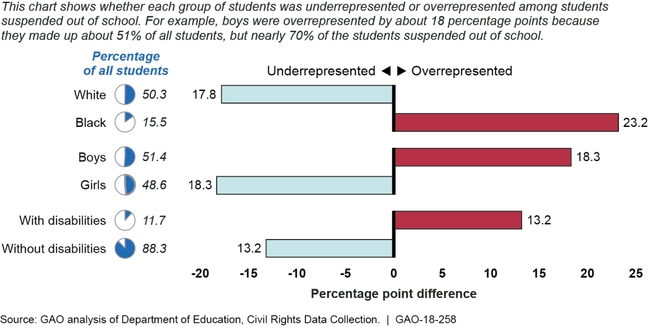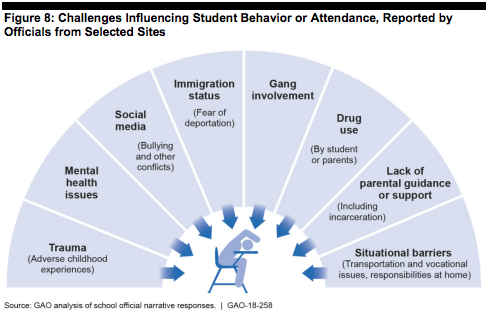Black students, boys, and students with disabilities were disproportionately disciplined in K-12 public schools, a new study finds.
The study, published by the non-partisan Government Accountability Office, examines Department of Education national civil rights data for the 2013–14 school year, the most recent available. Researchers interviewed school officials at five separate school districts about how they are addressing discipline and challenges they face given the complex issues influencing student behavior.
Lead researcher Jacqueline Nowicki told NPR that disparities in discipline were consistent “regardless of the type of disciplinary action, regardless of the level of school poverty, and regardless of the type of public school attended.”

(Chart: Government Accountability Office)
As illustrated by the chart above, black students, boys, and students with disabilities were far overrepresented in out-of-school suspensions. In fact, the study finds that black students “accounted for 15.5 percent of all public school students, but represented about 39 percent of students suspended from school—an overrepresentation of about 23 percentage points.”
Removing an unruly child from the classroom seems like an easy fix; however, repeatedly removing a child from his learning environment can have adverse effects on his education and, in some cases, can reward bad behavior for a child who wishes to get out of class. Officials in two of the school districts told the researchers they recognized the importance of using alternative methods to removing children from their learning environment. All five districts described changing their approach to discipline, with some alternatives including restorative justice practices and social-emotional learning.

(Chart: Government Accountability Office)
Several schools also cited a range of issues including poverty, mental-health issues, and family dysfunction as factors that contribute to behavior meriting discipline.
Students with learning disabilities or histories of poverty, neglect, or abuse are particularly vulnerable to removal-style discipline that leads to the “school to prison pipeline,” according to the American Civil Liberties Union, a national trend wherein “children are funneled out of public schools and into the juvenile and criminal justice systems.” Consistent with data from the GAO study, it seems that some public schools are attempting to move away from push-out trends that disproportionately affect vulnerable students.




